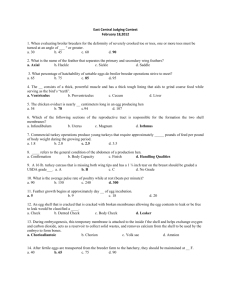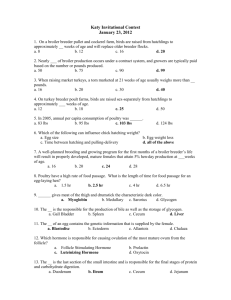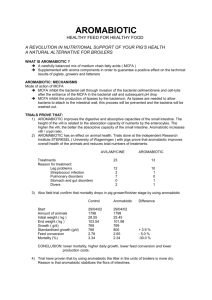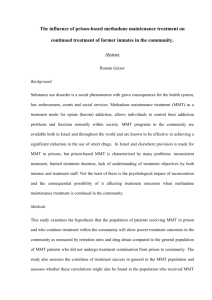Broiler production and consumption trends
advertisement
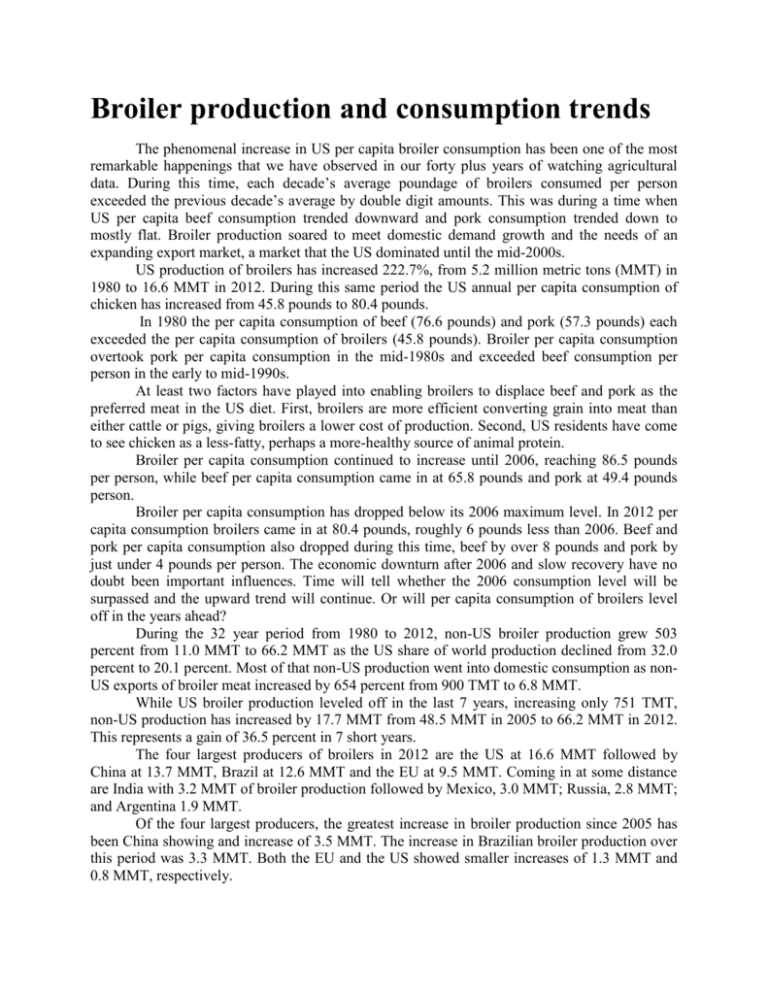
Broiler production and consumption trends The phenomenal increase in US per capita broiler consumption has been one of the most remarkable happenings that we have observed in our forty plus years of watching agricultural data. During this time, each decade’s average poundage of broilers consumed per person exceeded the previous decade’s average by double digit amounts. This was during a time when US per capita beef consumption trended downward and pork consumption trended down to mostly flat. Broiler production soared to meet domestic demand growth and the needs of an expanding export market, a market that the US dominated until the mid-2000s. US production of broilers has increased 222.7%, from 5.2 million metric tons (MMT) in 1980 to 16.6 MMT in 2012. During this same period the US annual per capita consumption of chicken has increased from 45.8 pounds to 80.4 pounds. In 1980 the per capita consumption of beef (76.6 pounds) and pork (57.3 pounds) each exceeded the per capita consumption of broilers (45.8 pounds). Broiler per capita consumption overtook pork per capita consumption in the mid-1980s and exceeded beef consumption per person in the early to mid-1990s. At least two factors have played into enabling broilers to displace beef and pork as the preferred meat in the US diet. First, broilers are more efficient converting grain into meat than either cattle or pigs, giving broilers a lower cost of production. Second, US residents have come to see chicken as a less-fatty, perhaps a more-healthy source of animal protein. Broiler per capita consumption continued to increase until 2006, reaching 86.5 pounds per person, while beef per capita consumption came in at 65.8 pounds and pork at 49.4 pounds person. Broiler per capita consumption has dropped below its 2006 maximum level. In 2012 per capita consumption broilers came in at 80.4 pounds, roughly 6 pounds less than 2006. Beef and pork per capita consumption also dropped during this time, beef by over 8 pounds and pork by just under 4 pounds per person. The economic downturn after 2006 and slow recovery have no doubt been important influences. Time will tell whether the 2006 consumption level will be surpassed and the upward trend will continue. Or will per capita consumption of broilers level off in the years ahead? During the 32 year period from 1980 to 2012, non-US broiler production grew 503 percent from 11.0 MMT to 66.2 MMT as the US share of world production declined from 32.0 percent to 20.1 percent. Most of that non-US production went into domestic consumption as nonUS exports of broiler meat increased by 654 percent from 900 TMT to 6.8 MMT. While US broiler production leveled off in the last 7 years, increasing only 751 TMT, non-US production has increased by 17.7 MMT from 48.5 MMT in 2005 to 66.2 MMT in 2012. This represents a gain of 36.5 percent in 7 short years. The four largest producers of broilers in 2012 are the US at 16.6 MMT followed by China at 13.7 MMT, Brazil at 12.6 MMT and the EU at 9.5 MMT. Coming in at some distance are India with 3.2 MMT of broiler production followed by Mexico, 3.0 MMT; Russia, 2.8 MMT; and Argentina 1.9 MMT. Of the four largest producers, the greatest increase in broiler production since 2005 has been China showing and increase of 3.5 MMT. The increase in Brazilian broiler production over this period was 3.3 MMT. Both the EU and the US showed smaller increases of 1.3 MMT and 0.8 MMT, respectively. US exports of broilers, especially in the form of chicken parts, are also an important segment of the broiler industry. In 1980, the US exported 257 thousand metric tons (TMT) of chicken. By 2012, exports had climbed to 3.3MMT, a gain of 1,185 percent, while imports, which began the period at zero have only climbed to 51TMT. In 1980, 5.0 percent of US broiler production was exported, by 2012 the share that was exported increased to 19.9 percent. US and Brazil are the main exporters of broilers, everyone else is far behind. The US was the world’s largest exporter of broilers until 2003, with Brazil taking the lead in 2004. In 2012, Brazil exported 27.7 percent of its production. The world’s 8 largest importers of broilers are more tightly grouped with imports ranging from 876 TMT to 300 TMT in 2012. The three largest importers are Japan, 876 TMT; Saudi Arabia, 799 TMT; and the EU, 718 TMT. Should US demand for broilers stagnate, as some believe it might, and Brazil continues to expand it’s broiler production to service export demand growth while China and other countries invest in additional resources to-grow-their-own, the days of heady growth in the consumption of US produced broilers may well be over. But what a run it was. Daryll E. Ray holds the Blasingame Chair of Excellence in Agricultural Policy, Institute of Agriculture, University of Tennessee, and is the Director of UT’s Agricultural Policy Analysis Center (APAC). Harwood D. Schaffer is a Research Assistant Professor at APAC. (865) 9747407; Fax: (865) 974-7298; dray@utk.edu and hdschaffer@utk.edu; http://www.agpolicy.org. Reproduction Permission Granted with: 1) Full attribution to Daryll E. Ray and Harwood D. Schaffer, Agricultural Policy Analysis Center, University of Tennessee, Knoxville, TN; 2) An email sent to hdschaffer@utk.edu indicating how often you intend on running the column and your total circulation. Also, please send one copy of the first issue with the column in it to Harwood Schaffer, Agricultural Policy Analysis Center, 309 Morgan Hall, Knoxville, TN 37996-4519.
